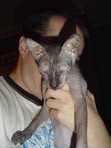Duncan and H.D. and "The Homosexual in Society"
It's out! It's Out!
The H.D. Book (The Collected Writings of Robert Duncan)
Jed Pearl at the New Republic wonders if it is the book that "could save American art."
Pearl brings up Hide /Seek and Duncan's "The Homosexual in Society":
I have been reading The H.D. Book off and on for the past month or so. Duncan's bold words have lifted my spirits at a time when the worlds of art and literature that I care about seem not only dangerously embattled but, worse yet, hopelessly distorted and demoralized. The Guggenheim Museum has had a huge hit this fall with "Chaos and Classicism: Art in France, Italy, and Germany, 1918-1936," an exhibition in which some of the grandest achievements of cosmopolitan modernism are wrenched into a scheme that leads straight to the totalitarian abhorrence of modernism. And the culture wars have heated up again. A flagrantly opportunistic right-wing attack on the inclusion of a video by David Wojnarowicz in the exhibition "Hide/Seek: Difference and Desire in American Portraiture," at the National Portrait Gallery in Washington, has been met not by a high-spirited and altogether necessary defense of the freestanding value of art but instead by liberal parochialism and identity politics. I would not presume to imagine what Duncan would have thought about either of these exhibitions, though I expect he would have been pleased that Jess [his life partner] is included in "Hide/Seek." Duncan's 1944 essay, "The Homosexual in Society," published in Dwight Macdonald's short-lived magazine, Politics, is mentioned in the catalogue of "Hide/Seek," but I am not sure if the organizers see Duncan's point, for he views the gay artist not as the spokesman for a particular identity but as a member of a larger community devoted to "a creative life and expression," and inextricably tied to "a devotion to human freedom, toward the liberation of human love, human conflicts, human aspirations."
Another quote:
Where Clement Greenberg, in his 1939 essay "Avant-Garde and Kitsch," saw the modern artist in flight from the heterogeneity of modern life, for Duncan the task of the modern artist is precisely to wrest some new alchemy from life's crazy quilt richness. No wonder Duncan speaks so warmly about collage—the art brilliantly practiced by his life partner, Jess—where "from what has been disregarded or fallen into disregard, genres are mixed, exchanges are made, mutations begun from scraps and excerpts from different pictures …form the figures of a new composition."
Publishers Weekly: Starred Review. Duncan's (1919–1988) great meditation on modernism's last remaining question mark finally sees print. Published as the first volume in California's Collected Writings of Robert Duncan series, this lovingly prepared volume presents this long critical work, written in 1960 and 1961, in its full form for the first time. It brilliantly reconstructs the dynamics of Pound, Williams, and H.D.'s complex, charged, evolving poet relations, and of H.D.'s eventual departure from the modernist mainstream into a classicism that exasperated Williams, but clearly fascinates Duncan. It reveals Duncan's own poetic relationship to H.D., with whom he corresponded late in the latter poet's life. It tracks a canonical murder, by which critics (beginning with Randall Jarrell) systematically exclude H.D. from the modernist pantheon. And it shows Duncan, whose great longer works lay ahead of him, struggling to find a poetic kernel within H.D.'s oeuvre. While this book is staged as an elaborate defense of H.D.'s work, and especially her austere and archaic-seeming late poetry, it is best read as the daybook of a poet as he absorbs, thinks through, departs from, returns to, and loves a major antecedent. (Jan.)











